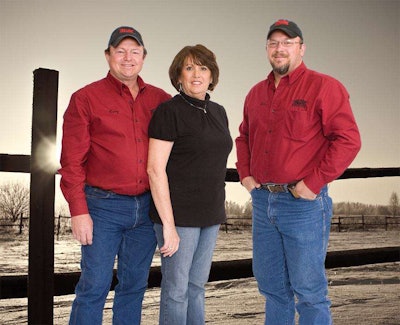
Larry and Linda Davis, with their son-in-law Scott Matlock.
Larry Davis grew up alongside his dad building homes. He continued the family tradition long after his father retired in the mid ’70s, building up a successful business with custom homes and developments and branched out into light commercial construction as well.
Not content to be a simple homebuilding operation, Larry has continued to diversify, creating a multi-faceted construction company with more than 40 employees and earthmoving and underground utility divisions while still maintaining a thriving commercial and residential operation. How? People, communication and knowing your numbers.
No “I” in teamwork
Larry is not the kind of guy who goes around pounding square pegs into round holes. What he has been able to do is find a role for each person who has walked into his life willing to work hard. And he let the natural abilities of these people flourish, even if that meant expanding the scope and nature of the work his company performs. And he’s done it in a careful and deliberate way that emphasizes teamwork.
“We try to avoid the word ‘I’ around our place,” Larry says. “It’s politically incorrect. When you work at L.E. Davis, the correct terminology is: ‘We’ did something,” he says.
Larry is also adamant about communication within the company. “We’re big on company-wide meetings; calling everybody in and talking about everything from top to bottom,” he says. “There’s nothing worse than keeping your people in the dark.”
Opportunity knocks
On New Year’s Eve, 1993, the Davis’ daughter Tori invited her date to the house, a young man named Scott Matlock. Larry was impressed, offered him a job; and the next morning Scott went to work for him. Scott continued part time that spring as a carpenter and laborer, while going to college. That summer he went to work full time for Larry. But Scott had potential beyond that of a carpenter, especially in the area of heavy equipment.
“On our bigger projects I would get the dirt work done and get them out of the ground and turn it over to one of our job superintendents for the building,” Scott says. That capability reduced the number of subcontractors Davis needed and helped with scheduling and execution too.
In 1996, Scott and Tori wed. Scott continued to sharpen his skills, not just earthmoving, but also the financial, bidding and estimating and management aspects of a construction company. His official title now is general manager and when Larry and Linda retire, he and Tori will step up to run the company.
“Larry and I probably get along better than 95 percent of the father-in-law or even father-son teams out there,” Scott says. “We really didn’t make a plan. We just grew into it.”
Getting heavy in a big way
In 2002, Grant Novak came into Larry’s office and declared that L.E. Davis needed to start a heavy equipment division and that he, Grant, was just the man to run it. Larry knew Grant from his work for another contractor, and was impressed by what he’d done. Larry quizzed Grant for four hours that day. Then he had Scott talk at length to Grant as well. They discussed it and decided to give Grant a shot.
“It was probably the riskiest thing I’ve ever done, but he sold me on the idea of underground utilities,” Larry says. “Grant is the kind of guy who is so confident you can’t convince him something can’t be done,” Larry says. “It doesn’t matter what it is, he will get it done.”
Thus the heavy equipment division of L.E. Davis was born. “We made some money on the first job,” Larry says, “but I could tell towards the end of it that we might have made more if we had done things differently.”
The 20-ton excavator they had rented was often idle and chewed into the profits. “Those machines don’t make you any money if they’re not moving,” he says. In subsequent heavy equipment jobs, Larry worked with Grant to set up efficient machine utilization and workflows. Grant, along with his crew chiefs, Brett Criner and Chance Winford, bring a level of experience to the company that few builders, residential or commercial, enjoy.
Married to the job
In the early days, Linda, Larry’s wife, kept the books and managed the office in addition to working as a hair stylist and raising the couples’ two daughters.
As the company grew, Linda’s sister Carmie took over the bookeeping and office management roles and Linda began growing into the role of designer, something she had a talent for and something Larry needed to delegate. In addition to doing interior colors and materials, Linda also helps clients refine floorplans and other architectural elements. Most recently she has sketched out ideas for two medical clinics and a bank exterior.
Linda’s work requires a lot of coordination with realtors, client meetings and extensive knowledge of products and materials. She also sets the budgets for the interiors. It was something Larry with his construction responsibilities didn’t have the time or the desire to focus on. And the combination of construction capabilities with interior design services gives the company an edge few can match.
With two housing developments and a regular stream of commercial construction projects, it’s a full time job for Linda and an assistant. “Larry has me doing something all the time,” she says.
Doing the right thing
In addition to managing for the best interests of his people and company, Larry also strives for the solution that works best, even for other contractors.
A few years back Larry started putting up metal buildings for some clients, going head to head with another contractor in the area. Davis’s crews excelled at doing the site work, utilities and mechanicals, but his crews never developed an efficient system for doing the metal frame erection and cladding the buildings.
One day he happened to be talking to his competitor and found out the competitor was great at frame erection and cladding but hated dealing with the site work and mechanicals. Now they partner. Davis does most of the man’s site work and mechanicals and his former competitor does what he does best which is raise and finish the buildings.
One thing Larry is careful about is not to steal people from other contractors. Gary Bundy, who maintains all of Davis’s equipment, was working as a jack of all trades for a local landscaper before he came to work for Davis. Everybody at L.E. Davis knew Bundy was a great mechanic, and a certified welder with a CDL license. Larry needed a mechanic and Bundy said he wanted to work for him. But before Larry offered him the job he talked to Bundy’s employer. As it turns out the landscaper was preparing for a downturn in his business and was grateful that Davis would be able to give Bundy a job.
Talent scout
Larry is also quick to spot talented craftspeople with specialized skills and create opportunities for them within the company. The head of his plumbing division, David Parker, was an independent contractor and doing some work for Davis, but the stress of managing his own one-man show was running him ragged. One day Larry happened to be talking to the local plumbing supplier who told him, “You need to hire this guy.” Larry thought it over, made Parker an offer and created a place for him in the business – a niche that’s dovetails well with the rest of the company’s skill sets and provides an important and profitable part of the L.E. Davis mix.
Brian Warner, one of the company’s newest supervisors, has a similar story. He was known locally as a top notch guy in residential construction, but was looking for bigger challenges, something more complex. Larry’s company, with a foot in both worlds, was the ideal environment for Brian to stretch his wings.
This personnel strategy has worked like a charm. “Despite having 40-plus employees, we’ve never had to put an ad in the paper,” Larry says.
Community involvement
Each year the company picks a charitable project. Most recently employees helped solicit donations and build a hospice building. Larry’s also served on the chamber of commerce, the area builders association and numerous local boards.
When the local community college called him up desperate to save its “carpentry” program, Larry put a task force together out of the local construction business owners. One of the first things he told the school was they had to quit thinking of it as a “carpentry” program and start promoting it as a “construction management program.” Larry helped the college define the curriculum and promoted the program to local high schools. He even teaches some of the classes himself and the class size has ballooned from four students to several dozen.
Master the details
Even though Larry entered the heavy equipment side of the business late, he’s been quick to master its details. “He’s very methodical,” says John Duke, a salesman at Riggs Cat. “He’s usually got the machine he wants picked out in his head before he comes to me. I just try to heed his advice. He’s very organized about it. And he goes to his operators and says: ‘I bought it, but it’s yours. You take care of it; you grease it and maintain it just like it belonged to you.’ He gets a fair price but he never tries to low-ball me. He makes good, reasonable offers. He wants me to make money just like he wants to make money.”
Davis’ careful and deliberate habits extend to all facets of the business. “He’s very detailed about his work,” says Blaise Koch, president and CEO of Ozark Refrigeration, a customer and supplier to the company. “Larry is very paperwork driven. Every L.E. Davis job is handled like every other L.E. Davis job. There’s continuity.”
Know your business
Scott Miller, president, Arvest Bank, has known Larry for about five years. “He and I have had a lot of conversations about this and we both think the same way,” Miller says. “If we’re going to get up in the morning and go to work, we’re going to make some money. He’s very aggressive with his bids, but he bids to make money, to meet his profit goals, and if he can’t do that, he lets it go.”
Larry attributes a lot of his business success to something his dad forced him to do back in 1971. His dad’s homebuilding company had a financial partner who took care of the construction financing. But when Larry came into the company, his dad forced him to work side by side with the partner.
Every Saturday morning the partner and Larry met and looked at the numbers. “We call it job costing now,” Larry says. “I thought the world of the partner, he was a shrewd businessman, but as a nineteen year old, I hated every minute of crunching those numbers. That went on for about two and half years, and my Saturday mornings were very boring.”
Eventually, Larry and his dad went their separate ways. But in starting up his own company Larry discovered something that surprised him. “I couldn’t stand not knowing what the numbers were,” he said. “Those Saturday meetings had created an obsession to know where I stood financially.”
The lesson he learned was to know your numbers, have a financial plan and manage debt. “Some business debt is almost inevitable, but with proper planning, should show a return on the money,” he says. “Personal debt will show no return on your money and can prevent you from obtaining the money needed to run your company,” he says. “A young builder that doesn’t watch his numbers, do job costing and budgeting, is destined for failure.”









